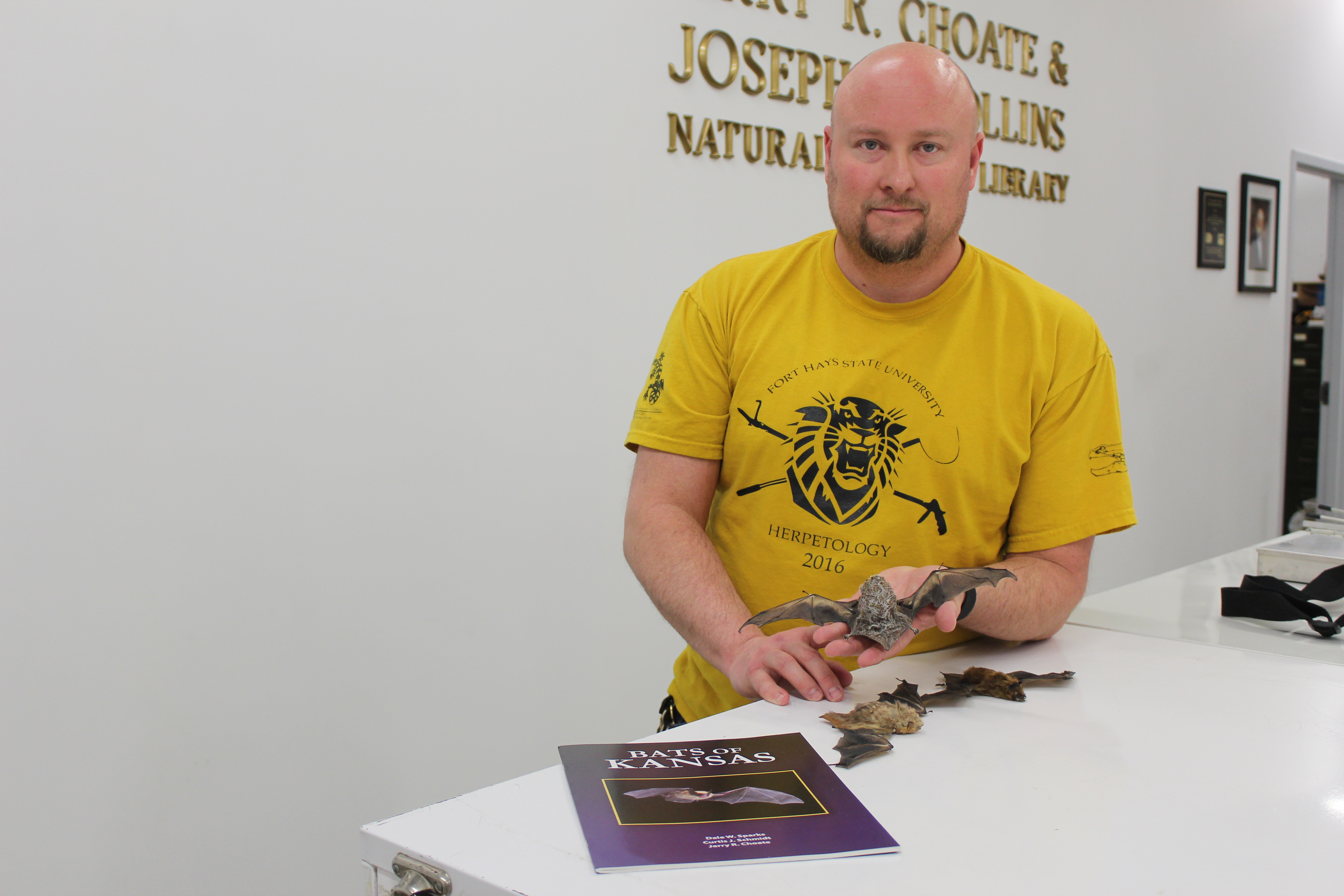
By CRISTINA JANNEY
Hays Post
A researcher at the Sternberg Museum of Natural History is studying a disease that is wiping out a species of bats across the nation.
Curtis Schmidt, Sternberg zoology collections manager, Elmer Fink, PhD, along with others from Fort Hays State University, have been studying the northern long-eared bat. Schmidt, although primarily trained as a herpetologist, co-wrote a book on Kansas bats with former Sternberg director Jerry Choate and two other scholars in 2011.
The northern long-eared bat was listed as threatened on the endangered species list in 2015. The bats, which normally live in caves, are succumbing to a fungal infection called white-nose syndrome that proves fatal in almost all cases.
The fungus was not introduced to the U.S. until 2006, but since has been decimating bat populations by the millions.
The fungal infection has not yet been found in Kansas.
The fungus that is affecting the bats is normally found in soil. However, it is being brought into caves by humans. People pick up the fungi on their shoes and carry it from one cave to another. The infection is also transferred from bat to bat and is carried from cave to cave by infected bats.
Bats have extremely high metabolisms. They have to be constantly eating when they are awake. When insects are scarce during the winter, some bat species, including the northern long-eared bat, hibernate. The fungal infection disrupts the bats’ hibernation. They become active in attempts to fight the illness, yet can’t feed, and starve to death, Schmidt said.
“It’s just spreading like wildfire,” he said, “and right now we have no idea how to control it.”
Some populations are showing they are starting to evolve resistance to the disease. One scientific paper suggested ultraviolet radiation will kill the fungus, but the caves in which the bats live are not exposed to ultraviolet radiation. If this solution proves effective, humans may have to go into the caves and provide ultraviolet radiation to kill the fungus.
Schmidt and his fellow researchers have banded about 700 to 800 bats during the last three years primarily in Ellis, Rooks, Russell and Trego counties. The scientists use fine mist nets to catch the bats as they search for water in the early evening. Contrary to the saying “blind as a bat,” bats can see. The bats use memory to locate water. The don’t start to echo locate for prey until later in the evening.
Researches don’t know much about where the bats roost or hibernates in Kansas. The bats use caves in other areas, but there are no caves in the areas in which the bats live in Kansas.

Schmidt acknowledged bats are often viewed negatively by the public. Seventeen species of bats live in Kansas, all of which are insect eaters. The bats not only eat mosquitoes, but many insects that can be harmful to crops. A study in Texas indicated bats had a $1.8 billion annual benefit to agriculture in the state.
The most common bat in Kansas is the big brown bat, and if you have seen a bat in Kansas that is probably what you observed.
Bats are actually quite abundant, but we just don’t usually see them because of their nocturnal lifestyle, Schmidt said.
“One thing people don’t realize is how abundant bats really are,” he said. “They are extremely abundant, very, very common. If we could actually see into the sky at night, you would see that the sky is full of bats, no matter where in the country you are.”
Schmidt will be giving a presentation at the Bat Fair from 2 to 4 p.m. Sunday at the Kansas Wetlands Education Center, 592 NE Kansas Highway 156, Great Bend.
He will be talk about a day in the life of a bat, which because of their high metabolism, involves primarily eating and sleeping.
Bats mate in the fall and the female bats will hold the live sperm until they are ready for the eggs to be fertilized in the spring. Bats, as mammals, give birth to live young and produce milk for their babies. Bats usually have two pup, but can have up to five. The baby bats grow rapidly and are able to fly and be independent of their mothers within two weeks.
Schmidt said he hopes through presentations such as the one in Great Bend he can raise awareness of the importance of bats.
“The No. 1 thing I like to promote is that they are OK, and they are good to have around,” he said. “I am really optimistic because it seems the more people are learning about them more recently with these diseases and things that are going on, the more people are appreciating and liking them. I have more people who come in and want to build bat houses because they realize how beneficial the bats are not only for agriculture, but for mosquitos and thing like that.”
Following Schmidt’s the presentation, children will be able to construct their own bats, complete a scavenger hunt in a “cave,” compare bat wing spans and “capture” and measure their own bats. KWEC will have live brown bats as well as several Sternberg Museum bat specimens on display.
The fair will also have examples and instructions on how to construct bat boxes, which can be used to attract bats to the yard.
For more information, contact KWEC at 877-243-9268.
